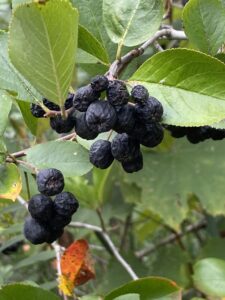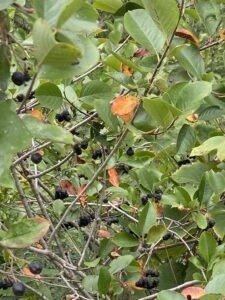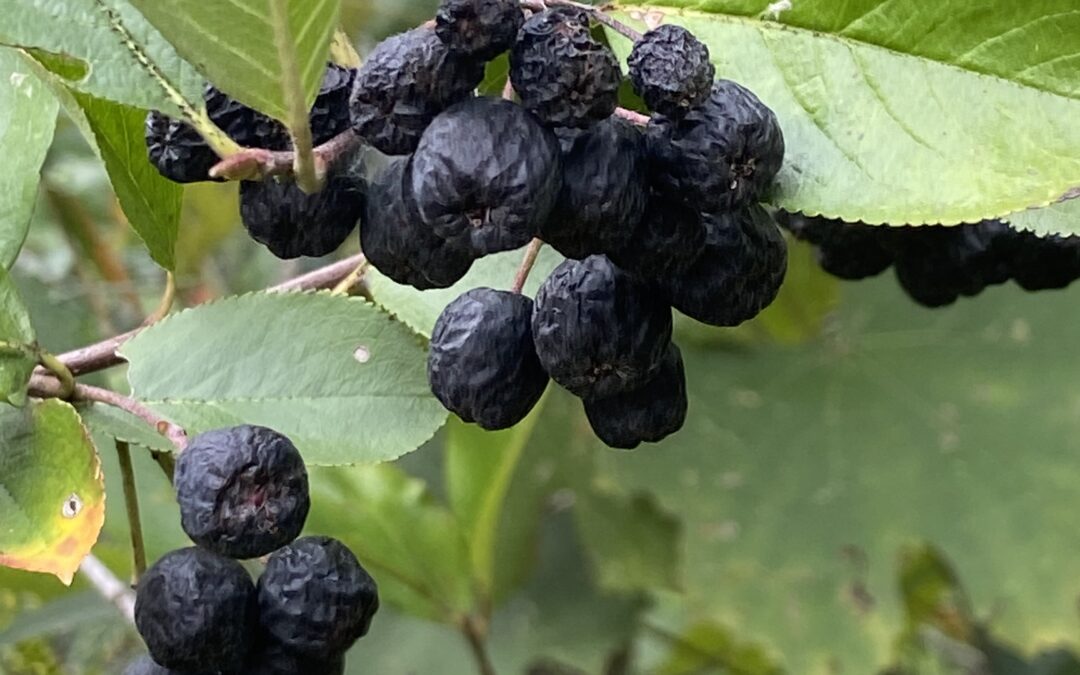Thank you, Aronia. I didn’t do squat for months, maybe years, and then I arrived to the greatest harvest one could imagine. A marginal fence, and nettles plants as tall as a high school basketball player didn’t deter this native bush from kicking out berries on every possible stem and sub-stem.

So, I picked. And picked. Until my fingers were blue-red, and people thought I was bleeding or had a contagious rash when I leaned in to shake their hand not so long after that. I carried that bounty back to the homestead, ok my house, and filled up resealable bags, which then, in turn, filled up my freezer. These small delights will provide sustenance and antioxidants for the months to come, via the morning smoothie. There is some continuity here. This berry ritual is reminiscent of my life in Seattle, Washington, where I became mildly obsessed with the unimaginable quantity of blackberries strewn about that city beginning in about July/August and seemingly never ending. Again, I picked and picked, using up hours of my non-existent family medicine residency free time, in parks throughout the city. The freezer was packed, the smoothie maker busy for months. I probably developed a blue hue with this nutritious behavior pattern.
Back to Wisconsin. A few years ago, I didn’t even know what Aronia was. Then, I heard about it from someone, or maybe saw the berries for sale (in preserve jar form) at a farmer’s market, remembering just two tidbits, enough to pique my interest: 1) it’s a native plant, so it grows well, and 2) one berry is your day’s need for antioxidants. WHAT?!? The latter couldn’t be true, but I didn’t care. I needed something that would grow, despite all of my inadvertent, neglectful efforts to prevent growth or any botanical expansion in size or height.
The context here is that I had inherited a vineyard with 400 grapevines, which sounds great at first, until I realized that Midwest vine management is fraught with challenges. First, it’s cold. And, not just regular cold, but bone chilling, mind numbing, finger amputating cold. I know it’s difficult to imagine, but plants don’t really like those conditions. Especially many of the grapevine varietals, who would rather be hanging out in California, or vacationing in France and Italy, reaching their warm climate potential. Really smart people and creative agriculturalists have developed cold-tolerant grape varieties with some legitimate promise. It’s just that you won’t be able to harvest your Cabernet, Zinfandel or Chardonnay grapes like many of us have become accustomed to drinking in liquid form. So, this is the first issue: a lot of effort is necessary to make a wine that you might not want to drink. And, to quote a wine making expert who helped with one of our first vintages, and responding to why he was interested in helping: “I want to see if we can make a Wisconsin wine that doesn’t suck.” That pretty much sums it up.
The second issue with my local effort at grape production is that there are about a thousand pests that want to take you down. I get it, grapes are tasty. I’m not selfish; I wouldn’t mind a 10% loss to keep the birds happy, it’s just that they are never satisfied with just 10%. We waited one day, a measly 24 hours, to harvest our grapes one season in order to meld better with people’s schedules over the Labor Day weekend, and that was enough to realize that maybe 20 grapes were left in the entire vineyard. I pictured every bird within 100 miles donning black clothing and ski masks, and traipsing around the vineyard with flashlights that night, harvesting to their beaks’ content. The reality is I don’t know how it happened. I just know the outcome: complete decimation.
And, that’s just the birds. There are insects, and insects galore. For example, I had assumed that grapevines had leaves, but that’s not the case if June bugs find them. They are self-centered gluttons; “Hey! What about my needs, the vineyard owner?!?” Grapevines need those leaves to generate energy and sugar to feed the grapes. I’m not a leaf expert, but do the math here: no leaves plus no energy equals no grapes. Thanks, bugs.
Have I mentioned the wasps, better known as Grape Killers? Arguably the most exasperating pest for a grape lover, they swing through the vineyard, right about harvest time, and poke a hole in every grape, ruining that grape in their quest to suck out a little bit of the juice. And, then they sting you when you come over to see what’s going on, trying to talk some sense into them about their aberrant behavior. Yes, this is a thing.
One more issue has to get mentioned because it’s the key to my subsequent Aronia fetish. The Midwest is humid, generally with a fair amount of spring, summer, and fall rain. Great for plants! They grow well, that is, once they survive the winter. What else likes this heat and humidity is every other living thing, including fungi, molds, rusts, and innumerable difficult-to-pronounce blights. Spores for these troublesome ecological characters are basically everywhere, and find grapes, begin to live on them, and swallow the grape whole leading to grape death, and, yes, go ahead and say it, no wine. The term for these grapes is “mummified”, and it’s everything you can imagine from what you’ve seen in museums and movies: a shriveled, small, dry, useless memory of a grape. And, this will happen unless…
…you use chemicals. There are some safe-ish biological ways to control the above-mentioned pests, but by far the most effective way to control the molds, fungi, and insects is to spray with a human made chemical. For me, an organic-oriented farmer, eater, drinker, and hiker, the chemical use was a deal breaker. I couldn’t see justifying making a marginal wine with the use of fungicides, maybe pesticides, especially so close to the farm house near where the vineyard was located.
When I heard that Aronia would grow well, WITH NO CHEMICALS, that was music to my ears, and I bought six small bushes to get the production going. They thrived, with basically no watering, and no additions to the soil. The harvests were small at first, as the plants were getting established, but then started to pick up, meet all of my smoothie needs and then some; I was able to share the fruits with friends and family members and have more than enough to go around.
Right around the second or third season, I think that some birds caught on to our side plan. A delay in harvesting finally brought me out to the patch (is patch the correct word?) and it seemed like there were fewer berries than I would have guessed. I had a sinking feeling, remembering the bad vineyard year. But, the damage was slight, and hasn’t recurred. I wonder if this detente will persist, but I’m grateful that the yearly Aronia harvest has translated into a full freezer, enough berries to last the winter.
Aronia is also called chokecherry or chokeberry, common names that make no sense to me although eating a raw berry does bring up a bit of a pause in the swallow mechanism. There’s a bitterness there that makes you wonder whether you should actually be eating it or not. It screams “Sweeten me!” And, that certainly is how a jam or jelly makes sense. A smoothie can also address the pucker, but it has to be carefully proportioned with other fruits or juices that take the edge off. Aronia doesn’t have the best marketing jingles: “Aronia: a little rough by itself!” “Aronia: add OJ to take the edge off!” “Aronia: what doesn’t kill you makes you stronger!” Anyway, I trusted this little blue berry and all of its healing potential.

The name Aronia is its origins in its scientific name, Aronia melanocarpa. Melano-, or dark, and -carpa, or covering. Yes, we know, it’s a dark-colored berry. That dark blue (some sources say dark red; I say tomato, you say tomato) is infamous for good stuff, pigments that are plant chemicals that also act as antioxidants and anti-inflammatory compounds in animals who eat them.
What accounts for Aronia berry’s dark blue/red is a class of plant compounds called anthocyanins, which is also present in high concentrations (Slimestad, 2005). There are four of these compounds, all with names ending in –side (for example, galactoside), that account for the deep, meaningful, standout color. And, these anthocyanins are found throughout the fruit and vegetable world, the chemical underpinning of why it is so important for humans to eat plants of a variety of colors as much as possible, hopefully on a daily basis. We need those antioxidants, of different types, to keep our immune system healthy, stave off cancer, and maintain a balanced amount of inflammation through our bodies. A blue fruit a day keeps the doctor away?
Outside of the blue/red-colored compounds, chokecherry has other compounds, including a class of plant chemicals called polyphenols, including phenolic acids. These chemicals have many, many effects in the human body (Mattila, 2006), so we want them. Lots of them. And, it seems like these phenolics account for most of the antioxidant activity (Slimestad, 2005), though anthocyanins also play a role (Wu, 2004). With respect to these phenolic acids, one research group looked at the phenolic acid content in a range of common berries, fruits and fruit-derived beverages, measuring the antioxidant amount in milligrams per 100 grams of the product (Mattila, 2006). The results? Number one was rowanberry with 103 mg/100g. Coming in a very close second place was our beloved chokecherry, with 96, then blueberry (85), sweet rowanberry (75), and Saskatoon berry (59).
Rounding out the discussion of how amazing Aronia is, there are two other plant chemical groups that play into its health benefits. One group are called chlorogenic acids, and this family of phytochemicals probably accounts for the aroma of Aronia (has a nice ring to it, The Aroma of Aronia!) (Slimestad, 2005). And, secondly, a very common group of compounds called flavonols are also present in Aronia (Slimestad, 2005). These compounds include quercetin, which I’ve written about before, and other flavonols, mostly colorless chemicals which pack an antioxidant and anti-inflammatory punch.
Clearly, we’re coming up with numerous reasons why humans should eat Aronia. What we haven’t touched on is the emerging scientific literature, including clinical trials in humans (such as Hawkins, 2021), showing that Aronia does just that, helps us! I’ll leave those details to our on-line dialogue through my blog, instagram, and website, so as not to delay you any longer from procuring your Aronia source and intake. Bon appetit!
References
Hawkins J, Hires C, Baker C, Keenan L, Bush M. Daily supplementation with aronia melanocarpa (chokeberry) reduces blood pressure and cholesterol: a meta analysis of controlled clinical trials. J Diet Suppl. 2021;18(5):517-530
Mattila P, Hellstro J, ToRroNen R. Phenolic Acids in Berries, Fruits, and Beverages. J. Agric. Food Chem. 2006;(54):7193−7199
Slimestad, R.; Torskangerpoll, K.; Nateland, H.; Johannessen, T.; Giske, N. Flavonoids from black chokeberries, Aronia melanocarpa. J. Food Compos. Anal. 2005;18:61-68.
Wu X, Gu L, Prior RL, McKay S. Characterization of anthocyanins and proanthocyanins in some cultivars of Ribes, Aronia, and Sambucus and their antioxidant capacity. J. Agric. Food Chem. 2004;52:7846–7856.


